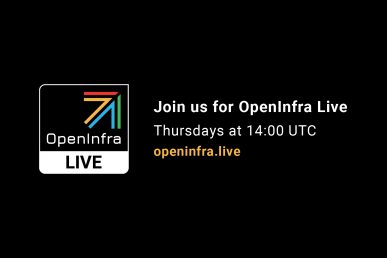Manila is an OpenStack service that provides filesystem shares as a service. Manila allows you to create filesystems like CIFS or NFS without having to worry about the block device backing it. Manila also makes it possible to have multiple clients accessing the same data. Differently from OpenStack Cinder volumes, which can only be attached to one virtual machine at the time, Manila creates shareable volumes using multiple filesystem standards. The standard Manila driver supports NFS and CIFS, and it can also create shares with GlusterFS, HDFS, CephFS and MapRFS. Manila doesn’t replace Cinder, but is another piece that makes your cloud more useful.
To get started with any OpenStack service, the best path is to deploy a development environment using Devstack. Follow the instructions below to setup a multi-node Devstack with Manila and Ceph as a storage back end.
Prep work
First, you need two servers to run Devstack on: these servers must have at least 8GB of RAM. You can set up Manila on a single server if you want, but you will be unable to test live migration. It’s important to note that Devstack will install packages system wide, so it’s better to run Devstack on a server whose only purpose is to run Devstack.
These servers need to talk to each other so open all ports between the two of them. Add each node’s IP and its name to each nodes /etc/hosts file so that each node can resolve its own and the other’s IP address using their names.
Finally, this has been tested on Ubuntu Xenial; other Linux distributions may or may not work.
Getting started
The first step is to create a user to run Devstack as and download Devstack. Do this by running the following on both nodes:
[user@devstack1]$ sudo useradd -s /bin/bash -d /opt/stack -m stack [user@devstack1]$ echo "stack ALL=(ALL) NOPASSWD: ALL" | sudo tee /etc/sudoers.d/stack [user@devstack1]$ sudo su - stack [stack@devstack1]$ git clone https://git.openstack.org/openstack-dev/devstack[user@devstack2]$ sudo useradd -s /bin/bash -d /opt/stack -m stack [user@devstack2]$ echo "stack ALL=(ALL) NOPASSWD: ALL" | sudo tee /etc/sudoers.d/stack [user@devstack2]$ sudo su - stack [stack@devstack2]$ git clone https://git.openstack.org/openstack-dev/devstack
Configuring the controller
After cloning the Devstack repository you must configure it. First configure the controller, the node that will run all of the OpenStack control services, such as the database and message queue. Use the sample local.conf below for the content of /home/devstack/local.conf:
[[local|localrc]]
#######
# MISC #
########
FLAT_INTERFACE=INTERFACE_NAME
FIXED_RANGE=10.4.128.0/20
FIXED_NETWORK_SIZE=4096
FLOATING_RANGE=192.168.42.128/25
ADMIN_PASSWORD=secretpassword
DATABASE_PASSWORD=$ADMIN_PASSWORD
RABBIT_PASSWORD=$ADMIN_PASSWORD
SERVICE_PASSWORD=$ADMIN_PASSWORD
#SERVICE_TOKEN = <this is generated after running stack.sh>
# Reclone each time
#RECLONE=yes
# Enable Logging
LOGFILE=/opt/stack/logs/stack.sh.log
VERBOSE=True
LOG_COLOR=True
SCREEN_LOGDIR=/opt/stack/logs
#################
# PRE-REQUISITE #
#################
ENABLED_SERVICES=rabbit,mysql,key
ENABLED_SERVICES+=,horizon,n-novnc
##########
# Manila #
##########
enable_plugin manila https://github.com/openstack/manila
enable_plugin manila-ui https://github.com/openstack/manila-ui
########
# CEPH #
########
enable_plugin devstack-plugin-ceph https://github.com/openstack/devstack-plugin-ceph
# DevStack will create a loop-back disk formatted as XFS to store the
# Ceph data.
CEPH_LOOPBACK_DISK_SIZE=30G
# Ceph cluster fsid
CEPH_FSID=$(uuidgen)
# Glance pool, pgs and user
GLANCE_CEPH_USER=glance
GLANCE_CEPH_POOL=images
GLANCE_CEPH_POOL_PG=8
GLANCE_CEPH_POOL_PGP=8
# Nova pool and pgs
NOVA_CEPH_POOL=vms
NOVA_CEPH_POOL_PG=8
NOVA_CEPH_POOL_PGP=8
# Cinder pool, pgs and user
CINDER_CEPH_POOL=volumes
CINDER_CEPH_POOL_PG=8
CINDER_CEPH_POOL_PGP=8
CINDER_CEPH_USER=cinder
CINDER_CEPH_UUID=$(uuidgen)
# Cinder backup pool, pgs and user
CINDER_BAK_CEPH_POOL=backup
CINDER_BAK_CEPH_POOL_PG=8
CINDER_BAKCEPH_POOL_PGP=8
CINDER_BAK_CEPH_USER=cinder-bak
# How many replicas are to be configured for your Ceph cluster
CEPH_REPLICAS=${CEPH_REPLICAS:-1}
# Connect DevStack to an existing Ceph cluster
REMOTE_CEPH=False
REMOTE_CEPH_ADMIN_KEY_PATH=/etc/ceph/ceph.client.admin.keyring
#####################
## GLANCE – IMAGE SERVICE #
###########################
ENABLED_SERVICES+=,g-api,g-reg
##################################
## CINDER – BLOCK DEVICE SERVICE #
##################################
ENABLED_SERVICES+=,cinder,c-api,c-vol,c-sch,c-bak
CINDER_DRIVER=ceph
CINDER_ENABLED_BACKENDS=ceph
###########################
## NOVA – COMPUTE SERVICE #
###########################
ENABLED_SERVICES+=,n-api,n-api-meta,n-cauth,n-crt,n-cpu,n-cond,n-sch,placement-api
LIBVIRT_TYPE=qemu
#NEUTRON
ENABLED_SERVICES+=,neutron,q-svc,q-agt,q-dhcp,q-l3,q-meta,q-lbaas
Replace “INTERFACE_NAME” with the networking interface that connects to the internet for your server. Once you have done this you are ready to run `./stack.sh` as the stack user to start your controller. This will take a while to finish, upwards of 30 minutes usually.
Next you need to configure the Manila services to use password authentication into the service VMs and not ssh-keys. First open the /etc/manila/manila.conf file in an editor and comment these lines under the [generic1] section:
#path_to_private_key = /opt/stack/.ssh/id_rsa #path_to_public_key = /opt/stack/.ssh/id_rsa.pub
and add the following under the [generic1] section:
service_instance_password = manila
Then restart the Manila devstack services:
[stack@devstack1]$ sudo systemctl restart devstack@m-\*
If you intend on running a single node Devstack you are done at this point, skip to the end of this article. If not, continue by configuring your compute node.
Configuring the compute node
Configure your compute node by adding the following to your /home/devstack/devstack.local.conf file:
[[local|localrc]] FLAT_INTERFACE=INTERFACE_NAME FIXED_RANGE=10.4.128.0/20 FIXED_NETWORK_SIZE=4096 FLOATING_RANGE=192.168.42.128/25 LOGFILE=/opt/stack/logs/stack.sh.log ADMIN_PASSWORD=secretpassword DATABASE_PASSWORD=$ADMIN_PASSWORD RABBIT_PASSWORD=$ADMIN_PASSWORD SERVICE_PASSWORD=$ADMIN_PASSWORD DATABASE_TYPE=mysql SERVICE_HOST=CONTROLLER_NODE_IP MYSQL_HOST=$SERVICE_HOST RABBIT_HOST=$SERVICE_HOST GLANCE_HOSTPORT=$SERVICE_HOST:9292 ENABLED_SERVICES=n-cpu,q-agt,n-api-meta,c-vol,placement-client,n-cauth NOVA_VNC_ENABLED=True NOVNCPROXY_URL="http://$SERVICE_HOST:6080/vnc_auto.html" LIBVIRT_TYPE=qemu
Be sure to substitute “CONTROLLER_NODE_IP” for the IP address of your controller node and “INTERFACE_NAME” with the networking interface that connects to the internet for your server.
Creating SSH keys for live migration
The next step is to create an ssh-key on each of your nodes as root:
[root@devstack1]$ ssh-keygen -t rsa -b 4096 [root@devstack2]$ ssh-keygen -t rsa -b 4096
Then hit enter for all of the questions, this will create a key without a password in the default location. Next copy each node’s host key to the other node using the following:
[root@devstack1]$ ssh-keyscan -H devstack2 | sudo tee -a /root/.ssh/known_hosts [root@devstack2]$ ssh-keyscan -H devstack1 | sudo tee -a /root/.ssh/known_hosts
Now copy the public key from each node onto the other node’s stack and root users’ authorized_keys file. This can be done by copying the contents of the .ssh/id_rsa.pub files into the .ssh/authorized_keys file for each user, or by running the following command if you have password auth setup:
[root@devstack1]$ ssh-copy-id -i /root/.ssh/id_rsa.pub stack@devstack2 [root@devstack1]$ ssh-copy-id -i /root/.ssh/id_rsa.pub root@devstack2 [root@devstack2]$ ssh-copy-id -i /root/.ssh/id_rsa.pub stack@devstack1 [root@devstack2]$ ssh-copy-id -i /root/.ssh/id_rsa.pub root@devstack1
This is necessary for live migration of instances to work properly. Now run the `./stack.sh` script as the stack user. It will take a while to complete on the compute node as well, but should be a bit quicker than the controller. After that completes we need to do two things, configure Libvirt to talk to Ceph and add our compute node to the cluster
Configuring Libvirt on the compute node
First copy the Ceph configurations from your controller to your compute node:
[root@devstack1]$ scp -r /etc/ceph devstack2:/etc/
Next copy the libvirt secrets to the compute nodes:
[root@devstack2]$ mkdir /etc/libvirt/secrets [root@devstack1]$ scp /etc/libvirt/secrets/*.xml devstack2:/etc/libvirt/secrets/
Now install the ceph-common package that will provide some basic ceph client commands. Then configure libvirt to know how to talk to Ceph.
[root@devstack2]$ apt install ceph-common
[root@devstack2]$ cd /etc/libvirt/secrets
[root@devstack2]$ sudo virsh secret-define --file $(CINDER_CEPH_UUID}.xml
[root@devstack2]$ sudo virsh secret-set-value --secret ${CINDER_CEPH_UUID} \
--base64 $(sudo ceph -c /etc/ceph/ceph.conf \
auth get-key client.cinder)
Next configure Cinder to talk to Ceph, do this by copying the [ceph] section of your controller node’s /etc/ceph/ceph.conf to your compute node. Then configure Nova to talk to Ceph by copying the [libvirt] section of your controller node to your compute node, replacing the existing [libvirt] section.
Then restart the nova and cinder services on your compute node with the following:
[root@devstack2]$ systemctl restart devstack@n-\* [root@devstack2]$ systemctl restart devstack@c-\*
Adding the compute node to the cluster
After your compute node is running. Run the following on your controller to add the compute nodes to the cluster:
[stack@devstack1]$ devstack/tools/discover_hosts.sh
Now you have devstack running with Manila and Ceph.
Testing Manila
The easiest way to test Manila is to create a share. Start by sourcing your cloud credential:
[stack@devstack1]$ . ~/devstack/openrc
And get a list of networks available:
[stack@devstack1]$ neutron net-list
Next, create a Manila share on the network:
[stack@devstack1]$ manila share-network-create --neutron-net-id <PRIVATE_NET_ID> --neutron-subnet-id <PRIVATE_SUBNET_ID> --name manila-share-network [stack@devstack1]$ manila share-network-list [stack@devstack1]$ manila create --name share1 --share-network <SHARE_NET_ID> NFS <SIZE_IN_GB>
This will create a volume share using NFS and the new share network. Now check its status using:
[stack@devstack1]$ manila list
If the share’s status reaches “available” it is ready to be used. If it enters the “error” state, it has failed and it is possible your devstack configuration is broken.
Note: These instructions were tested with devstack commit 0d9c896cddbb3660cad342d44770af1ac2ec1365.
Superuser is always interested in community content, get in touch: editorATopenstack.org
Cover Photo // CC BY NC
- How to deploy Manila in a multi-node Devstack environment - August 25, 2017

)










